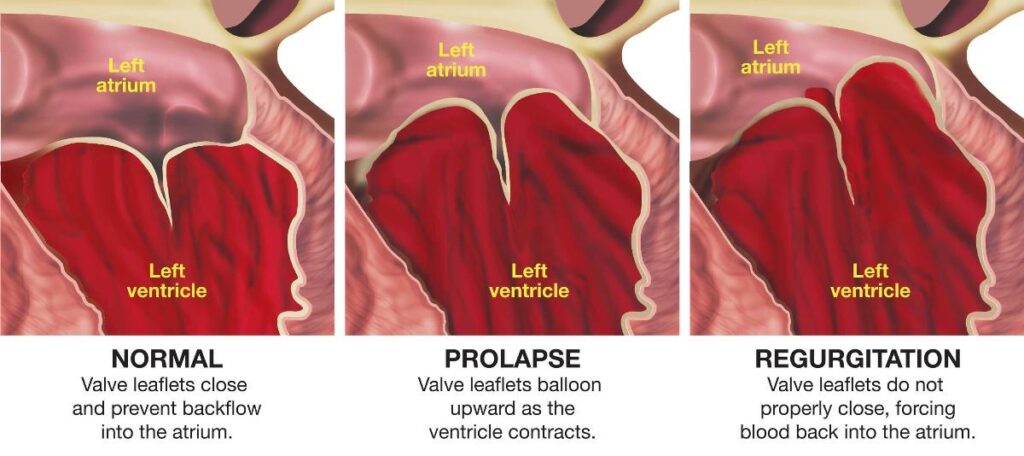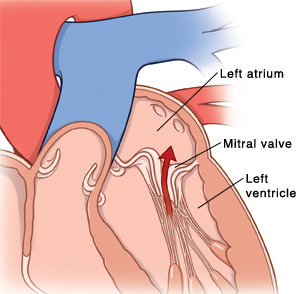What is a mitral valve prolapse?
Mitral valve prolapse, also called MVP, is a relatively common condition where the mitral valve (the inlet valve to the left sided pumping chamber) does not work correctly. In this condition the two flaps of the mitral valve, called the leaflets, don’t close smoothly or evenly. This is due to one or both of the leaflets of the mitral valve moving beyond the point where they should stop and bulging into the left atrium. While this happens, the 2 leaflets hitting each other cause a typical noise called a systolic click.

This condition is also known commonly as Barlow’s syndrome. In some children the bulge of the flap can be so pronounced that a back flow (regurgitation) can be seen. You can see a graphic view of a normal valve and a prolapsing valve in the image below.
What happens to the heart during mitral valve prolapse?
The function of the mitral valve is to close when the heart is pumping, avoiding any back flow of blood into the left atrium and the lungs. In this condition, when the left side of the heart contracts (pumps), part of one or both leaflets collapses backward into the left atrium.

Closeup of 4-chamber view of heart, focusing on left atrium and showing mitral valve prolapse SOURCE: Based on 115695
This is often due to the mitral valve leaflets being too large and thick or the supporting strings are too stretchy. In some cases, a small gap can develop between the 2 leaflets and this can cause some blood to flow back. This back flow is called regurgitation or leakage and can cause a heart murmur.
You can watch an animation of a prolapsing mitral valve.
How common is mitral valve prolapse?
It occurs in around 1-2% of the population so it fairly common. This condition affects boys as much as girls.
Can mitral valve prolapse occur in children?
It can occur in children and adolescents as well as in adults. This condition is unusual in newborn and very small children and becomes more common during childhood and adolescence. The cause of that is not known but it is clearly related to the development of the heart.
What causes mitral valve prolapse? Is it hereditary?
It is caused by is abnormally stretchy (or myxomatous in medical jargon) mitral valve leaflets. It can have a genetic cause. There are many syndromes where it is very common. In these condition usually the connective tissue is affected: Marfan syndrome, Elhers-Danlos syndrome, etc.
Besides the forms of MVP associated with syndromes, it can occur in families, where multiple generations and people can be affected. MVP is associated with chest wall deformities like pectus excavatum and pectus carinatum, scoliosis and hypermobile joints.
It can also be seen in children who have a history of rheumatic fever.
How is mitral valve prolapse detected?
The majority of people with this condition do not have cardiac symptoms. As a result, the diagnosis is usually the result of a referral for a systolic click or a heart murmur which is heard during a general clinical consultation. Sometimes the diagnosis of MVP is made during the cardiology assessment of children with suspected Marfan or Ehlers-Danlos Syndrome, connective tissue diseases or chest wall deformities. Once a diagnosis is suspected, the child needs to be reviewed by a paediatric cardiologist who will undertake an echocardiogram to confirm the diagnosis.
How does mitral valve prolapse affects the body?
It may not affect the body directly if the valve is perfectly competent and has no leakage. If the valve has a significant leakage then this can cause the left side of the heart to swell progressively and can cause children and adolescents to start complaining of easy tiredness and breathlessness. Additionally mitral valves with prolapse and regurgitations are at higher risk of getting infected, causing infective endocarditis.
What are the signs, symptoms and complications of mitral valve prolapse?
Because most patients with MVP do not have symptoms, a heart murmur detected during a routine physical exam when listening to the heart with a stethoscope may be the only sign. Common symptoms described by children and adolescents with mitral valve prolapse include include:
- bursts of fast heartbeat (palpitations),
- chest discomfort and pain,
- anxiety and fatigue.
Children with associated mitral valve regurgitation can also describe breathlessness as a symptom. Significant amounts of mitral valve regurgitation can ultimately cause the heart to enlarge and subsequently to fail if left untreated. Valves with MVP are also at slightly higher risk of getting infected, a condition known as infective endocarditis.
What should I do if a heart murmur is detected?
Even for those children and adolescents who do not have symptoms, an echocardiogram is usually recommended if they have a murmur detected which is suggestive of MVO.
The echocardiogram is able to confirm the diagnosis of MVP and also to identify the extent of prolapse and to quantify the extent of any mitral valve leakage (regurgitation). In some children a Holter ECG monitor or a cardiac MRI might be required.
Is mitral valve prolapse dangerous?
In most cases, this condition is harmless. Most people with mitral valve prolapse are unaware of it and their health isn’t affected. However, up to 10% of people with MVP and progressive regurgitation may require treatment and this is usually represented by surgery to repair (and sometimes replace) the mitral valve. Medications may also be used at times to help the heart the heart to deal with the regurgitation and to delay surgery.
Does mitral valve prolapse need to be treated?
For many people mitral valve prolapse is a finding on the echocardiogram which requires periodic follow up but no treatment and no change in lifestyle. People with MVP and regurgitation may require treatment in they are getting symptoms like breathlessness or very easy fatigue, if the mitral valve regurgitation is becoming more severe, if the left atrium and the left ventricle are becoming progressively more enlarged, if the pumping function of the the left side of the heart starts dropping or if children and adolescents develop arrhythmia or palpitations. Arrhythmias and palpitations are more common in children and adolescents with mitral valve prolapse as the regurgitation from the valve can cause the heart to enlarge and this may trigger problems with the heart rhythm.
What is the best treatment option for mitral valve prolapse? Does it require surgery?
Most children and adolescents with this condition do not require treatment. Those with severe or increasing mitral valve regurgitation or with symptoms may require treatment. Whenever possible treatment consists in the repair of the mitral valve to make the regurgitation disappear or reduce. In some instances, when the tissue of the valve is not of good quality or when the valve is significantly damaged then the whole valve may need to be replaced, most commonly with a mechanical valve but other alternatives are available in younger children.

